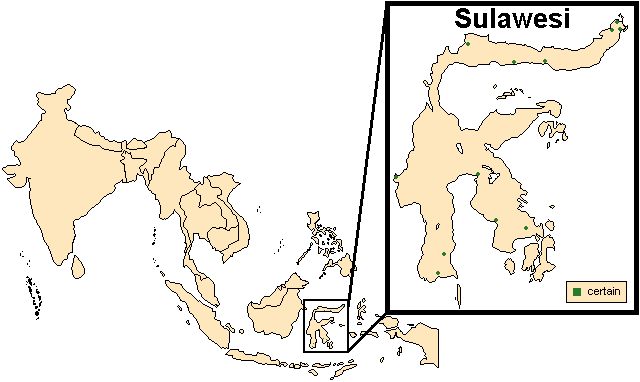![]() Return
to Artiodactyla
Return
to Artiodactyla
Classification
|
 Bubalus
depressicornis
Bubalus
depressicornis
Lowland anoa
![]()
Taxonomy
 |
 |
 |
Click on the images above for a larger view of the
photographs
|
||
General Characteristics
Body Length: 180 cm / 6 ft.
Shoulder Height: 85 cm / 2.8 ft.
Tail Length: 40 cm / 16 in.
Weight: Up to 300 kg / 660 lb.The thick black hide is covered with short, dark brown hair, with males tending to be darker than females. The undersides may be light brown. There are white markings on the head and lower legs, and a white crescent-shaped throat bib. The young are born a bright rufous-orange colour. The plump body is supported by stout limbs. The short, triangular-based horns are found in both sexes and are flattened along the top. They begin at the edge of the forehead and point diagonally backwards, growing 18-37 cm / 7-14.5 inches in length.
Ontogeny and Reproduction
Gestation Period: 9-10 months.
Young per Birth: 1
Weaning: Supposedly 6-9 months.
Sexual Maturity: 2-3 years.
Life span: Up to 30 years.
Ecology and Behavior
Anoas feed during the morning, resting in shade through the hottest parts of the day. The preferred gait is a walk, though when fleeing, they are known to make clumsy leaps. Their bodies are very efficient at crashing through the forest undergrowth, with the short horns being held close to the back in order to avoid being tangled. However, if cornered or approached within a critical distance, anoas will turn and attack violently. The anoa is considered very excitable and dangerous to its opponents, as its sharp horns can be used as daggers. This is especially true for young bulls in the breeding season, and females with young. Several anoa fatalities in zoos have resulted from attempts to keep these solitary animals in pairs or groups, with the larger animals disemboweling their counterparts with their horns.Family group: Solitary
Diet: Vegetation.
Distribution
Damp, dense undergrowth on the island of Sulawesi.

Range Map (Localities redrawn from Groves, 1969)
Conservation Status
The lowland anoa is classified as endangered by the IUCN (1996).
Remarks
While it has previously been classified under a separate genus, Anoa, the lowland anoa is now grouped with the water buffalo. Anoa is the Celebes word for buffalo. Boubalos (Greek) a buffalo. De- (Latin) down from; presso (Latin) I press; cornu (Latin) the horn of an animal, the horns are short and depressed backwards.
Literature Cited
Buchholtz, C. 1990. Cattle. In Grzimek's Encyclopedia of Mammals. Edited by S. P. Parker. New York: McGraw-Hill. Volume 5, pp. 360-417.Groves, C. P. 1969. Systematics of the anoa (Mammalia, Bovidae). Beaufortia; 17: 1-12.
Nowak, R. M. [editor]. 1991. Walker's Mammals of the World (Fifth Edition). Baltimore: The Johns Hopkins University Press.
Wilson, D. E., and D. M. Reeder [editors]. 1993. Mammal Species of the World (Second Edition). Washington: Smithsonian Institution Press. Available online at http://nmnhwww.si.edu/msw/
Additional Resources
Frank, S., K. Eulenberger, M. Rohleder, and H. H. D. Meyer. 1997. Reproduction of anoa (Bubalus (Anoa) depressicornis) monitored by fecal progestin analysis. Zeitschrift fuer Saeugetierkunde; 62(SUPPL. 2): 59-65.Goritz, F., T. Hildebrandt, G. Notzold, K. Eulenberger, J. Gottschalk, S. Frank, and H. Correia. 1994. Untersuchungen zum reproduktiven Status und Zyklusgeschehen beim Anoa (Bubalus depressicornis) mittels transrektaler Ultrasonographie. Erkrankungen der Zootiere; 36: 107-117.
Groves, C. 1982. Antilope depressicornis H. Smith, 1827, and Anoa quarlesi Ouwens, 1910 (Mammalia, Artiodactyla): proposed conservation. Bulletin of Zoololical Nomenclature 39: 281-282.
Jahja, M.M. (1987) The possibility of breeding anoa in captivity: An alternative for conservation of the species. Biotrop Special Publications 30: 101-108.
Kakoi, H., T. Namikawa, O. Takenaka, A. Takenaka, T. Amano, and H. Martojo. 1994. Divergence between the Anoas of Sulawesi and the Asiatic water buffaloes, inferred from their complete amino acid sequences of hemoglobin beta chains. Zeitschrift fuer Zoologische Systematik und Evolutionsforschung; 32(1): 1-10.
Kikkawa, Y., Yonekawa, H., Suzuki, H. and Amano,T. (1997) Analysis of genetic diversity of domestic water buffaloes and anoas based on variations in the mitochondrial gene for cytochrome b. Animal Genetics 28(3): 195-201.
Melisch, R.( 1995) Anoa threatened by souvenir trade in South Sulawesi, Indonesia. Oryx 29(4): 224-225.
Mustari, A.H. (1995) Population and behaviour of Lowland Anoa (Bubalus depressicornis) in Tanjung Amolengu Wildlife Reserve South-East Sulawesi, Indonesia. Unpublished M.Sc. thesis, Faculty of Forestry Science, Georg-August University, Göttingen, Germany.
O'Brien, T. G., and M. F. Kinnaird. 1996. Changing populations of birds and mammals in North Sulawesi. Oryx; 30(2): 150-156.
Pitra, C., R. Furbass, H. M. Seyfert. 1997. Molecular phylogeny of the tribe Bovini (Mammalia: Artiodactyla): Alternative placement of the Anoa. Journal of Evolutionary Biology; 10(4): 589-600.
Schreiber, A., and G. Nötzold. 1995. One EEP, but how many anoas? In EEP Yearbook 1994/95. Edited by F. Rietkerk, K. Brouwer, and S. Smits. EAZA/EEP Executive Office, Amsterdam, The Netherlands. pp. 419-424.
Schreiber, A, G. Nötzold, and M Held. 1993. Molecular and chromosomal evolution in anoas (Bovidae: Bubalus spec.). Zeitschrift fuer Zoologische Systematik und Evolutionsforschung; 311): 64-79.
Schreiber, A., I. Seibold, G. Notzold, and M. Wink. 1999. Cytochrome b gene haplotypes characterize chromosomal lineages of anoa, the Sulawesi dwarf buffalo (Bovidae: Bubalus sp.). Journal of Heredity; 90(1): 165-176.
Syam, A. 1978. Study of habitats and population of anoa (Anoa depressicornis) H. Smith in Mount Tangkoko Batuangus Nature Reserve, north Sulawesi. Lembaga Penelitian Hutan (Bogor) Laporan 288: 1-47.
Tanaka, K., C. D. Solis, J. S. Masangkay, K. I. Maeda, Y. Kawamoto, T. Namikawa. 1996. Phylogenetic relationship among all living species of the genus Bubalus based on DNA sequences of the cytochrome b gene. Biochemical Genetics; 34(11-12): 443-452.
Whitten, A.J., M. Mustafa, and G. S. Henderson. 1987. The Ecology of Sulawesi. Yogyakarta, Indonesia: Gadjah Mada University Press.
Zhang, Y. 1985. Macroscopical anatomy of kidney of (Anoa depressicornis). Sichuan Journal of Zoology; 4(3): 33.
Return to Artiodactyla

![]()
© Brent Huffman, www.ultimateungulate.com |
|
|